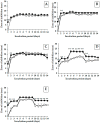Isolation and Identification of Bioactive Compounds from Streptomyces actinomycinicus PJ85 and Their In Vitro Antimicrobial Activities against Methicillin-Resistant Staphylococcus aureus
- PMID: 36551454
- PMCID: PMC9774200
- DOI: 10.3390/antibiotics11121797
Isolation and Identification of Bioactive Compounds from Streptomyces actinomycinicus PJ85 and Their In Vitro Antimicrobial Activities against Methicillin-Resistant Staphylococcus aureus
Abstract
Antibiotic-resistant strains are a global health-threatening problem. Drug-resistant microbes have compromised the control of infectious diseases. Therefore, the search for a novel class of antibiotic drugs is necessary. Streptomycetes have been described as the richest source of bioactive compounds, including antibiotics. This study was aimed to characterize the antibacterial compounds of Streptomyces sp. PJ85 isolated from dry dipterocarp forest soil in Northeast Thailand. The 16S rRNA gene sequence and phylogenetic analysis showed that PJ85 possessed a high similarity to Streptomyces actinomycinicus RCU-197T of 98.90%. The PJ85 strain was shown to produce antibacterial compounds that were active against Gram-positive bacteria including methicillin-resistant Staphylococcus aureus (MRSA). The active compounds of PJ85 were extracted and purified using silica gel column chromatography. Two active antibacterial compounds, compound 1 and compound PJ85_F39, were purified and characterized with spectroscopy, including liquid chromatography and mass spectrometry (LC-MS). Compound 1 was identified as actinomycin D, and compound PJ85_F39 was identified as dihomo-γ-linolenic acid (DGLA). To the best of our knowledge, this is the first report of the purification and characterization of the antibacterial compounds of S. actinomycinicus.
Keywords: Streptomyces actinomycinicus; Streptomyces sp.; antibacterial activity; dihomo-γ-linolenic acid; drug-resistant microorganisms.
Conflict of interest statement
The authors declare no conflict of interest.
Figures





Similar articles
-
Purification and characterization of actinomycins from Streptomyces strain M7 active against methicillin resistant Staphylococcus aureus and vancomycin resistant Enterococcus.BMC Microbiol. 2019 Feb 19;19(1):44. doi: 10.1186/s12866-019-1405-y. BMC Microbiol. 2019. PMID: 30782119 Free PMC article.
-
Cell wall distraction and biofilm inhibition of marine Streptomyces derived angucycline in methicillin resistant Staphylococcus aureus.Microb Pathog. 2021 Jan;150:104712. doi: 10.1016/j.micpath.2020.104712. Epub 2020 Dec 28. Microb Pathog. 2021. PMID: 33359358
-
Susceptibility pattern of methicillin resistance Staphylococcus aureus (MRSA) by flow cytometry analysis and characterization of novel lead drug molecule from Streptomyces species.J Infect Public Health. 2021 Dec;14(12):1831-1841. doi: 10.1016/j.jiph.2021.11.001. Epub 2021 Nov 9. J Infect Public Health. 2021. PMID: 34782289
-
Novel actinomycin group compound from newly isolated Streptomyces sp. RAB12: isolation, characterization, and evaluation of antimicrobial potential.Appl Microbiol Biotechnol. 2018 Feb;102(3):1241-1250. doi: 10.1007/s00253-017-8696-4. Epub 2017 Dec 21. Appl Microbiol Biotechnol. 2018. PMID: 29270734
-
Phytochemicals with activity against methicillin-resistant Staphylococcus aureus.Phytomedicine. 2022 Jun;100:154073. doi: 10.1016/j.phymed.2022.154073. Epub 2022 Apr 1. Phytomedicine. 2022. PMID: 35397285 Review.
Cited by
-
Isolation, Characterization of Pyraclostrobin Derived from Soil Actinomycete Streptomyces sp. HSN-01 and Its Antimicrobial and Anticancer Activity.Antibiotics (Basel). 2023 Jul 20;12(7):1211. doi: 10.3390/antibiotics12071211. Antibiotics (Basel). 2023. PMID: 37508307 Free PMC article.
-
Nontargeted Metabolomics of Streptomyces Sourced from Thailand Reveals the Presence of Bioactive Metabolites.ACS Omega. 2025 Mar 11;10(11):11567-11579. doi: 10.1021/acsomega.5c00669. eCollection 2025 Mar 25. ACS Omega. 2025. PMID: 40160742 Free PMC article.
-
Purification and characterization of an antimicrobial compound against drug-resistant MRSA and VRE produced by Streptomyces levis strain HFM-2.Sci Rep. 2025 Jul 18;15(1):26016. doi: 10.1038/s41598-025-10572-3. Sci Rep. 2025. PMID: 40676119 Free PMC article.
-
Identification and application of a strong bidirectional acmN2p promoter from actinomycin D-producing streptomycetes.Eng Microbiol. 2023 Oct 11;4(1):100121. doi: 10.1016/j.engmic.2023.100121. eCollection 2024 Mar. Eng Microbiol. 2023. PMID: 39628790 Free PMC article.
-
Probiotics and Their Bioproducts: A Promising Approach for Targeting Methicillin-Resistant Staphylococcus aureus and Vancomycin-Resistant Enterococcus.Microorganisms. 2023 Sep 25;11(10):2393. doi: 10.3390/microorganisms11102393. Microorganisms. 2023. PMID: 37894051 Free PMC article. Review.
References
-
- Baltz R.H. Antimicrobials from actinomycetes: Back to the future. Microbe. 2007;2:125–133.
Grants and funding
LinkOut - more resources
Full Text Sources

